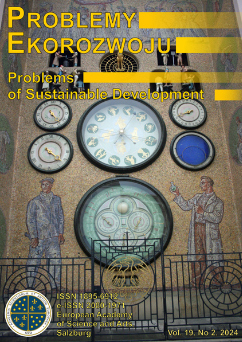Humanistyczne perspektywy różnorodności biokulturowej
Ryszard F. Sadowski
Cardinal Stefan Wyszynski University in Warsaw, Institute of Ecology and Bioethics, Wóycickiego 1/3, building 23, 01-938 Warsaw, Poland (Polska)
Abstrakt
Powszechnie zauważa się, że różnorodność biokulturowa jest ważnym elementem światowego dziedzictwa. Do niedawna koncentrowano się głównie na różnorodności biologicznej. Od lat 80 XX w. zwrócono także uwagę na znaczenie różnorodności kulturowej i językowej. Konrad Lorenz wskazał, że procesy cywilizacyjne zagrażają już nie tylko różnorodności ziemskiego dziedzictwa, ale nawet człowieczeństwu człowieka. Opracowanie to stawia sobie za cel pokazanie wzajemnych zależności pomiędzy różnorodnością biologiczną, kulturową i językową a biologiczną i kulturową warstwą człowieka. Podstawą tego opracowania była koncepcja różnorodności biokulturowejLuisyMaffi oraz warstwowa koncepcja człowieka wg Konrada Z. Lorenza. Przeprowadzone badania potwierdzają istnienie wzajemnych zależności między różnymi formami ziemskiego dziedzictwa a warstwami człowieka. Wskazują też, że dobra kondycja różnorodności biokulturowej wpływa pozytywnie na kondycję człowieka. Podobnie dobra kondycja człowieka pozytywnie wpływa na jakość ziemskiej różnorodności. Przeprowadzone badania prowadzą do wniosku, że zespoły badawcze, które dokonują analiz procesów cywilizacyjnych nie mogą ograniczać się do przedstawicieli nauk przyrodniczych, technicznych, ekonomicznych i prawnych. W zespołach tych powinni być także humaniści. Pozwoli to lepiej uchwycić złożoność zachodzących procesów cywilizacyjnych i odpowiedzieć na nie w sposób bardziej adekwatny.
Słowa kluczowe:
różnorodność biokulturowa, różnorodność biologiczna, różnorodność kulturowa, różnorodność lingwistyczna, regres człowieczeństwa, Konrad LorenzBibliografia
BACON F., 2009, The New Organon: or True Directions Concerning the Interpretation of Nature, Dodo Press, Gloucestershire 2009.
Google Scholar
BROSIUS J.P.; HITCHNER S.L., 2010, Reconceptualising the link between cultural diversity and biodiversity: beyond the biocultural perspective, in: International Social Science Journal, 61(199), p. 141-168.
Google Scholar
CAILLON S., DEGEORGES P., 2007, Biodiversity: negotiating the border between nature and culture, in: Biodiversity and Conservation, 16(10), p. 2919-2931.
Google Scholar
CARDINALE B.J., et al., 2012, Biodiversity loss and its impact on humanity, in: Nature, 486(7401), p. 59-67.
Google Scholar
DESCARTES R., 2015, Meditations on First Philosophy, Cambridge University Press, Cambridge.
Google Scholar
DESCARTES R., 2008, Principles of Philosophy, Barnes & Noble, New York.
Google Scholar
DÍAZ S., et al., 2006, Biodiversity Loss Threatens Human Well-Being, in: PLOS Biology, 4(8),
Google Scholar
https://doi.org/10.1371/journal.pbio.0040277.
Google Scholar
ELDER J.; FINCH R., 2002, Nature Writing: the Tradition in English, W W Norton & Company, New York.
Google Scholar
FRANCIS (pope), 2015, Praise be to You - Laudato Si: On Care for our Common Home, Ignatius Press, San Francisco.
Google Scholar
HARMON D., LOH J., 2010, The Index of Linguistic Diversity: A New Quantitative Measure of Trends in the Status of the World's Languages, in: Language Documentation & Conservation, 4, p. 97-151.
Google Scholar
HORKHEIMER M., ADORNO Th.W., 2002, Dialectic of Enlightenment. Philosophical Fragments, Stanford University Press, Stanford.
Google Scholar
KOLBERT E., 2014,The Sixth Extinction: An Unnatural History, Henry Holt and Company, New York.
Google Scholar
LEWIS M.P., et al., 2016, Ethnologue: Languages of the World, SIL International, Dalla.
Google Scholar
LORENZ K., 1978, Behind the Mirror. A Search for a Natural History of Human Knowledge, Harcourt Brace Jovanovich, New York.
Google Scholar
LORENZ K., 1974, Civilized Man’s Eight Deadly Sins, Harcourt Brace Jovanovich, New York.
Google Scholar
LORENZ K., 1989, The Waning of Humaneness, UNIWIN Paperbacks, London.
Google Scholar
MAFFI L., 2007, Biocultural Diversity and Sustainability, in: The SAGE Handbook of Environment and Society; ed. Pretty J., et. al., SAGE, London, p. 267-277.
Google Scholar
McKIBBEN B., 1989, The End of Nature, Random House, New York.
Google Scholar
SADOWSKI R., 2016, Genetic Engineering in the Light of Dialectic of Enlightenment, in: Return to the Oikos. Ways to Recover our Common Home, ed. Kureethadam J.I., et. al., LAS, Rome, p. 194-212.
Google Scholar
SADOWSKI R.F., 2017, Call for Integral Protection of Biocultural Diversity, in: ProblemyEkorozwoju/ Problems of Sustainable Development, 12(2), p. 37-45.
Google Scholar
SCHUMACHER E.F., 2014, Small is Beautiful. Economics as if People Mattered, Harper Perennial, New York.
Google Scholar
SKUTNABB-KANGAS T., 2002, Why Should Linguistic Diversity be Maintained and Supported in Europe? Some Arguments, Council of Europe, Strasbourg.
Google Scholar
STEPHENS C., 2015, The indigenous experience of urbanization, in: State of the World’s Minorities and Indigenous Peoples 2015, ed. Grant P., Minority Rights Group, London, p. 54-61.
Google Scholar
STERLING E.J., et al., 2017, Biocultural approaches to well-being and sustainability indicators across scales, in: Nature ecology & evolution, 1(1), p. 1798-1806.
Google Scholar
UNFPA,2007, State of the World Population 2007. Unleashing the Potential of Urban Growth, UNFPA, New York.
Google Scholar
UNITED NATIONS, 1986, Proclamation of the World Decade for Cultural Development, UN, New York.
Google Scholar
WORLD BANK, 2015, Indigenous Latin America in the Twenty-First Century. The First Decade, World Bank Group, Washington.
Google Scholar
Autorzy
Ryszard F. SadowskiCardinal Stefan Wyszynski University in Warsaw, Institute of Ecology and Bioethics, Wóycickiego 1/3, building 23, 01-938 Warsaw, Poland Polska
Statystyki
Abstract views: 24PDF downloads: 9
Licencja

Utwór dostępny jest na licencji Creative Commons Uznanie autorstwa – Na tych samych warunkach 4.0 Miedzynarodowe.




